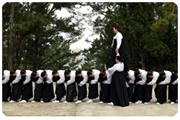Keeping in step with the cheerful and repetitive melody, a woman with a good voice sings the first part of each line, leading the chorus, and the other women respond with the refrain, “ganggangsullae.” As the full moon starts to rise, they hold hands and begin to move to the right as if they are drawing a circle on the ground and slowly accentuating their actions with a variety of patterned movement with such descriptive titles as “play, tortoise,” “breaking off the fern,” “rolling and unrolling the straw mat,” “tying and untying the string of herrings,” and “treading on roof tiles.” In addition, they can improvise and change the song lyrics as they sing aloud, allowing their words to give full vent to the joys and sorrows of the women.
The first part of the dance is slow, but the rhythm becomes faster as it progresses to the latter part; as the dancers gradually become more excited, their movements change briskly and dynamically. Sometimes, dancers experience a moment of complete abandonment to such an extent that one dancer stated, “When the dance reaches a climax, even the thought of my husband or my children vanishes from my mind completely. Only my body lost in ecstasy exists!” Indeed, there is a hypnotizing quality to the circle dance, so that it is not uncommon for participants to end up spending the entire night performing the dance.
The ganggangsullae circle dance is prevalent in the southern Jeolla province, especially in places like Haenam, Muan, Gangjin, Boseong, and Goheung, and the offshore islands of Jindo and Wando. There is a theory that Admiral Yi Sun-shin invented the dance during the Japanese Invasions of 1592-1598, but there are also many competing theories on the dance’s origins. Theories on the origin of the name of the dance itself are also numerous. What is clear, however, is that in days when there were few games for women, the circle dance served as a favorite pastime for women. Made up of simple movements accompanied by a song with an easy melody, the dance could be quickly learned so that anyone could participate. In addition, it was a game that bonded the women who participated into a community consciousness. While many women held hands in a circle and responded to the singing, the exhilarating melodies played with the traditional Korean instruments added fervor to the dance.
|





 >
>